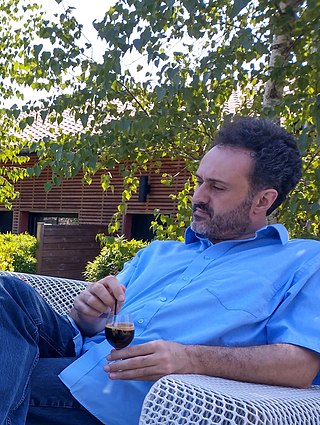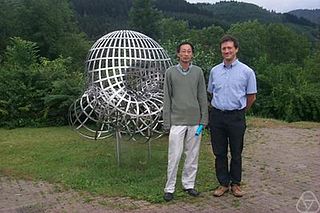Related Research Articles
Noncommutative geometry (NCG) is a branch of mathematics concerned with a geometric approach to noncommutative algebras, and with the construction of spaces that are locally presented by noncommutative algebras of functions, possibly in some generalized sense. A noncommutative algebra is an associative algebra in which the multiplication is not commutative, that is, for which does not always equal ; or more generally an algebraic structure in which one of the principal binary operations is not commutative; one also allows additional structures, e.g. topology or norm, to be possibly carried by the noncommutative algebra of functions.
In mathematical physics, geometric quantization is a mathematical approach to defining a quantum theory corresponding to a given classical theory. It attempts to carry out quantization, for which there is in general no exact recipe, in such a way that certain analogies between the classical theory and the quantum theory remain manifest. For example, the similarity between the Heisenberg equation in the Heisenberg picture of quantum mechanics and the Hamilton equation in classical physics should be built in.
In mathematics, the field with one element is a suggestive name for an object that should behave similarly to a finite field with a single element, if such a field could exist. This object is denoted F1, or, in a French–English pun, Fun. The name "field with one element" and the notation F1 are only suggestive, as there is no field with one element in classical abstract algebra. Instead, F1 refers to the idea that there should be a way to replace sets and operations, the traditional building blocks for abstract algebra, with other, more flexible objects. Many theories of F1 have been proposed, but it is not clear which, if any, of them give F1 all the desired properties. While there is still no field with a single element in these theories, there is a field-like object whose characteristic is one.
In mathematics, especially (higher) category theory, higher-dimensional algebra is the study of categorified structures. It has applications in nonabelian algebraic topology, and generalizes abstract algebra.

Michael Jerome Hopkins is an American mathematician known for work in algebraic topology.

Noncommutative algebraic geometry is a branch of mathematics, and more specifically a direction in noncommutative geometry, that studies the geometric properties of formal duals of non-commutative algebraic objects such as rings as well as geometric objects derived from them.
In mathematics, more specifically category theory, a quasi-category is a generalization of the notion of a category. The study of such generalizations is known as higher category theory.

Richard Paul Winsley Thomas is a British mathematician working in several areas of geometry. He is a professor at Imperial College London. He studies moduli problems in algebraic geometry, and ‘mirror symmetry’—a phenomenon in pure mathematics predicted by string theory in theoretical physics.
In mathematics, the Gelfand–Zeitlin system is an integrable system on conjugacy classes of Hermitian matrices. It was introduced by Guillemin and Sternberg (1983), who named it after the Gelfand–Zeitlin basis, an early example of canonical basis, introduced by I. M. Gelfand and M. L. Cetlin in 1950s. Kostant and Wallach (2006) introduced a complex version of this integrable system.
Derived algebraic geometry is a branch of mathematics that generalizes algebraic geometry to a situation where commutative rings, which provide local charts, are replaced by either differential graded algebras, simplicial commutative rings or -ring spectra from algebraic topology, whose higher homotopy groups account for the non-discreteness of the structure sheaf. Grothendieck's scheme theory allows the structure sheaf to carry nilpotent elements. Derived algebraic geometry can be thought of as an extension of this idea, and provides natural settings for intersection theory of singular algebraic varieties and cotangent complexes in deformation theory, among the other applications.
In algebraic geometry, a derived stack is, roughly, a stack together with a sheaf of commutative ring spectra. It generalizes a derived scheme. Derived stacks are the "spaces" studied in derived algebraic geometry.
In mathematics, in particular abstract algebra and topology, a homotopy Lie algebra is a generalisation of the concept of a differential graded Lie algebra. To be a little more specific, the Jacobi identity only holds up to homotopy. Therefore, a differential graded Lie algebra can be seen as a homotopy Lie algebra where the Jacobi identity holds on the nose. These homotopy algebras are useful in classifying deformation problems over characteristic 0 in deformation theory because deformation functors are classified by quasi-isomorphism classes of -algebras. This was later extended to all characteristics by Jonathan Pridham.
Sheldon H. Katz is an American mathematician, specializing in algebraic geometry and its applications to string theory.
This is a glossary of properties and concepts in symplectic geometry in mathematics. The terms listed here cover the occurrences of symplectic geometry both in topology as well as in algebraic geometry. The glossary also includes notions from Hamiltonian geometry, Poisson geometry and geometric quantization.

Bertrand Toën is a mathematician who works as a director of research at the Centre national de la recherche scientifique (CNRS) at the Paul Sabatier University, Toulouse, France. He received his PhD in 1999 from the Paul Sabatier University, where he was supervised by Carlos Simpson and Joseph Tapia.
Anton Yurevich Alekseev is a Russian mathematician.

Alexandre Mikhailovich Vinogradov was a Russian and Italian mathematician. He made important contributions to the areas of differential calculus over commutative algebras, the algebraic theory of differential operators, homological algebra, differential geometry and algebraic topology, mechanics and mathematical physics, the geometrical theory of nonlinear partial differential equations and secondary calculus.
Dmitri Olegovich Orlov, is a Russian mathematician, specializing in algebraic geometry. He is known for the Bondal-Orlov reconstruction theorem (2001).

Giovanni Felder is a Swiss mathematical physicist and mathematician, working at ETH Zurich. He specializes in algebraic and geometric properties of integrable models of statistical mechanics and quantum field theory.

Alberto Sergio Cattaneo is an Italian mathematician and mathematical physicist, specializing in geometry related to quantum field theory and string theory.
References
- ↑ Toën, Bertrand; Vezzosi, Gabriele (2005). "Homotopical algebraic geometry I: topos theory". Advances in Mathematics . 193 (2): 257–372. arXiv: math/0207028 . doi: 10.1016/j.aim.2004.05.004 . S2CID 119131806.
- ↑ Toën, Bertrand; Vezzosi, Gabriele (2008). "HAG II". Memoirs of the American Mathematical Society . 193 (902): 1–228.
- ↑ "ncatlab entry: Homotopical Algebraic Geometry". ncatlab. Retrieved February 10, 2018.
- ↑ "ncatlab entry: Derived Algebraic Geometry". ncatlab.
- ↑ "Harvard DAG learning seminar" . Retrieved February 10, 2018.
- 1 2 MSRI. "Program "Derived Algebraic Geometry"". MSRI. Retrieved April 19, 2018.
- ↑ Pantev, Tony; Toën, Bertrand; Vaquié, Michel; Vezzosi, Gabriele (2013). "Shifted symplectic structures". Publ. Math. IHÉS . 17 (1): 271–328. arXiv: 1111.3209 . doi:10.1007/s10240-013-0054-1. S2CID 11246087.
- ↑ Calaque, Damien; Pantev, Tony; Toën, Bertrand; Vaquié, Michel; Vezzosi, Gabriele (2017). "Shifted Poisson structures and deformation quantization". Journal of Topology . 10 (2): 483–584. arXiv: 1506.03699 . doi:10.1112/topo.12012. S2CID 117757610.
- ↑ Toën, Bertrand. "Derived algebraic geometry and deformation quantization" (PDF). ICM-talk (2014). Retrieved February 10, 2018.
- ↑ Blanc, Anthony; Robalo, M.; Toen, B.; Vezzosi, Gabriele (2016). "Motivic Realizations of Singularity Categories and Vanishing Cycles". arXiv: 1607.03012 [math.AG].
- ↑ Toën, Bertrand; Vezzosi, Gabriele (2017). "Trace formula for dg-categories and Bloch's conductor conjecture I". arXiv: 1710.05902 [math.AG].
- ↑ Vezzosi, Gabriele. "Applications of non-commutative algebraic geometry to arithmetic geometry". IHES channel- YouTube. Retrieved April 18, 2018.
- ↑ Hennion, Benjamin; Porta, Mauro; Vezzosi, Gabriele (2016). "Formal gluing along non-linear flags". arXiv: 1607.04503 [math.AG].
- ↑ Antieau, B.; Vezzosi, G. (2017). "A remark on the Hochschild–Kostant–Rosenberg theorem in characteristic p". arXiv: 1710.06039 [math.AG].
- ↑ MFO Seminar. "MFO Seminar, Derived Geometry". MFO. Retrieved April 18, 2018.